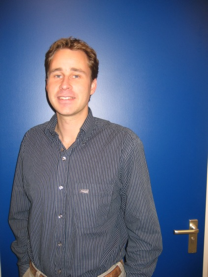Nanoscale properties of complex oxide films
Promotion date: 17. April 2008
Thesis advisors: Prof.dr.ing. Dave Blank, Prof.dr. Malcolm Beasley (Stanford University)
Assistant thesis advisor: Dr.ir. Gertjan Koster
| As miniaturization continues, layers in devices are made thinner and their properties become increasingly difficult to measure. There are techniques available to measure a wide range of properties of materials at nanometer length scales and measure the extremely small signals that they produce. This thesis focusses on the use of such techniques to |
How did you come across the subject of your promotion project?
I didn’t have a very clear plan at the start. When I started working in Stanford we revised an existing evaporation apparatus. We tested the system using SrRuO3, a very widely used oxide that has both good conducting and magnetic properties. From there we started studying very thin films of SrRuO3, using pulsed laser deposition.
What is special about studying this material in this way?
Together with another thesis-student we developed a unique measuring apparatus. To look for magnetic properties on the scale of layers of only a few cells of material, you must detect and interpret very small signals. We found that magnetic and conductivity properties suddenly come into being, together, when you vary the thickness from three to four cell layers.
Can you mention some other results?
There are the ones I like and the ones the scientific community likes ...
Which one do you like?
We investigated copper-oxide, which has a very asymmetric crystal structure. We forced it to grow in a more symmetric way, and could prove that we obtained a different structured copper-oxide of only two nano-meters thickness. The measuring principles we used were very special. In fundamental physics this material is under further investigation for their superconductivity properties.
And ... in what topic are physicists more interested?
Physics of interfaces is a hot topic nowadays. We put together two isolating materials, of which the interface region has conducting properties. We used photoemission techniques to show this. The results are still a bit controversial.
How did you experience working at Stanford University?
The groups there are smaller, which forces people to work together with other disciplines. That’s an interesting feature. But as a researcher it was very nice to work on the same floor with Nobelprize winners and writers of famous academic books and articles.
What are your future plans?
In December I am starting a two-year post-doc project at Berkeley University. We will focus on thin layers again, but for a very different type of materials. I am most specialized in growing this layers. Together with other specialists, we will construct new techniques to measure properties of this new nano-scale materials.
So, you choose for academic research again?
Yes, in academic research you have the ultimate freedom. In company research you sometimes have to stop interesting projects, because customer’s wishes prevail.
Nevertheless, in academic research you also have to plan your investigations carefully. In a promotion project you show that you are able to do so.
What is an important feature of MESA+ to stay successful in the future?
MESA+ is a great institution. A lot of different groups work under one roof, doing related things. I found that working together creates a lot of extra results. With our group, Inorganic Materials Science, we collaborate closely with the Low Temperature Division (Horst Rogalla) and Computational Materials Science (Paul Kelly).
The building of new facilities, that takes place now, can mean a big step forward for MESA+. The groups now have a great deal of experience, that the can develop further with the help of these new facilities.

